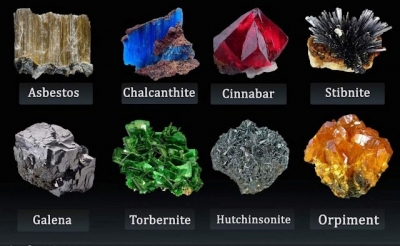
|
Minerals are natural chemicals from which Earth’s crust is formed. There are around 2000 individual minerals, each with a unique colour and shape. A few are powdery or resinous, but most are crystals. Some minerals, such as gold and silver, are pure chemical elements, but the majority are compounds, of which silicates are most common. |
The earth is composed of mineral elements, either alone or in a myriad of combinations called compounds. A mineral is composed of a single element or compound. By definition, a mineral is a naturally occurring inorganic substance with a definite chemical composition and ordered atomic structure.
- Table salt is a mineral called sodium chloride. Its ordered structure is apparent because it occurs in crystals shaped like small cubes.
- Another common mineral is quartz, or silicon dioxide. Its crystals have a specific hexagonal shape. Coal is a mineral composed entirely of carbon, originally trapped by living organisms through the process of photosynthesis.
- The carbon in coal is therefore of organic origin which leads some authorities to object to the definition of a mineral as an inorganic substance.
- Limestone is a rock composed of a single mineral calcium carbonate. On the basis of their origin on earth rocks may be divided into three primary categories: igneous, sedimentary and metamorphic.
Minerals have been broadly classified into two classes, primary minerals and secondary minerals. Minerals which were formed by igneous process that is from the cooling down of the molten materials called magma, have been put in the primary category, while those formed by other processes have been put in the secondary category. Primary minerals which occur in the sand fractions of the soil had not undergone any change.
Other primary minerals had been altered to form the secondary minerals for example, the primary mineral mica had been altered to form the secondary mineral illite. Some other primary minerals for example, olivine, anorthite, hornblende etc., had been completely decomposed; the decomposition products recombined together to form the secondary minerals.
Minerals may be identified by their crystal structure, physical properties and chemical composition.
Like vitamins, minerals help your body grow, evolve and remain healthy. The body uses minerals to perform many functions — from building strong bones to nerve impulse transmission. Some minerals also create hormones or hold a regular heartbeat.
Credit: Byju’s
Picture credit: Geology In




